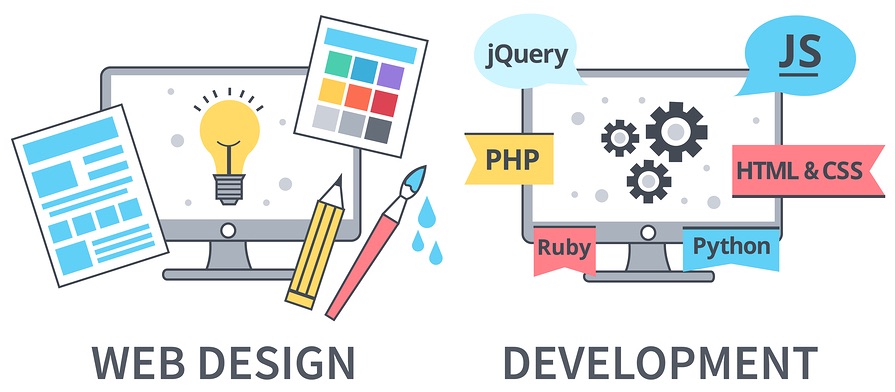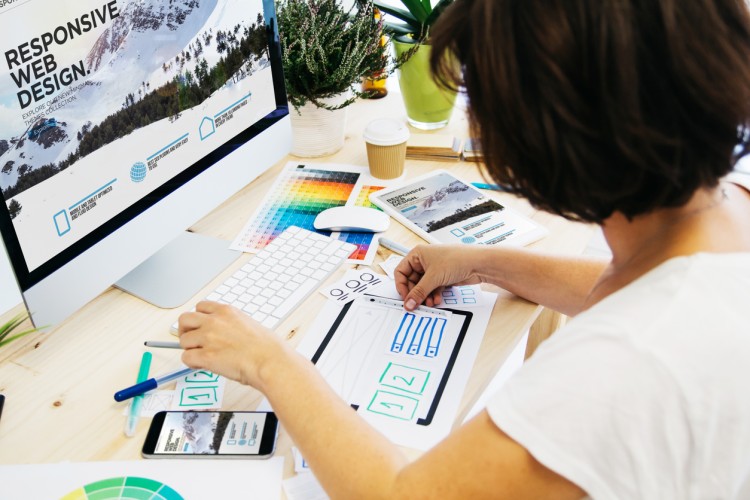All Regarding Web Design: Understanding Its Importance for Your Online Visibility
Internet layout acts as a basic facet of developing an on the internet existence. It influences user experiences and shapes assumptions of brands. Effective internet layout includes different aspects that boost use and engagement. As the electronic landscape progresses, comprehending the importance of these design concepts ends up being essential (branding). What are the key components that make a website not simply functional, yet compelling? Exploring this can disclose vital insights for any individual aiming to do well online
The Role of Web Layout in Individual Experience
Website design profoundly affects user experience by forming how site visitors interact with an internet site. Components such as design, color pattern, and typography produce the impression, directing customers through the material. Reliable internet design focuses on intuitive navigating, making sure that site visitors can easily discover details without disappointment. Furthermore, responsive style boosts accessibility throughout different tools, satisfying a wider audience. The rate of a site likewise plays a critical role; slower-loading web pages can bring about greater bounce prices and lowered individual complete satisfaction. Aesthetic pecking order, attained via spacing and size modifications, guides individuals' interest to vital features or calls to activity. Uniformity in layout components cultivates familiarity and count on, encouraging users to involve even more deeply. Inevitably, a properly designed web site not just brings in site visitors yet additionally maintains them, influencing their total perception of the brand or solution it represents. In this method, internet layout is an essential element of a successful online presence.
Key Components of Reliable Web Layout
Efficient web design pivots on numerous key components that improve individual engagement and fulfillment. Visual pecking order concepts guide individuals via material, guaranteeing that essential information stands apart - web design. Mobile responsiveness is necessary in an electronic landscape where individuals accessibility websites throughout different devices.
Aesthetic Hierarchy Concepts
Many components contribute to a successful internet site, the principles of visual power structure stand out as foundational to directing customer experience. Visual hierarchy describes the setup of layout aspects to communicate value and direct users' attention properly. Secret factors include size, spacing, comparison, and shade, which assist focus on information and produce a flow that is intuitive for users. Bigger components generally draw the eye initially, while contrasting shades can highlight phone call to action. Thoughtful spacing can additionally enhance readability and comprehension. By applying these principles, designers can craft a smooth experience that not only involves users however likewise facilitates navigation and improves total use. Ultimately, a well-executed visual pecking order improves the web site's performance in sharing its message.
Mobile Responsiveness Basics
Mobile responsiveness is a vital part of modern website design, making sure that web sites work seamlessly across numerous tools and display dimensions. This versatility improves user experience, as visitors can access material effortlessly whether they make use of a desktop, tablet, or smart device. Trick components of mobile responsiveness consist of liquid grids, versatile images, and media questions, which permit formats to readjust dynamically. Focusing on touch-friendly navigation and understandable typography additionally boosts use on smaller displays. Furthermore, enhancing loading speeds is crucial, as mobile customers typically expect fast access to information. By implementing these basics, web developers produce sites that involve individuals, lower bounce rates, and ultimately add to boosted conversions and customer satisfaction. Mobile responsiveness is therefore necessary for preserving an affordable on the internet visibility.
The Effect of Website Design on Brand Name Understanding
Website design substantially influences brand perception, beginning with the crucial initial perception a web site makes on visitors. Constant aesthetic aspects boost trust and recognition, strengthening the brand's identity. Furthermore, a favorable customer experience can shape exactly how customers engage and check out with the brand name in general.
Perceptions Matter
Their initial reaction can greatly influence their assumption of the brand name when visitors come across an internet site. A well-designed website can evoke feelings of integrity, expertise, and trust fund, while a poorly created one might activate suspicion and question. Users often create judgments within secs, making the initial impact important. Aspects such as layout, shade systems, and typography play substantial functions in shaping these first thoughts. A modern-day and clean layout can convey development, whereas obsolete visuals may recommend neglect. Additionally, an intuitive navigating system improves customer experience, strengthening favorable perceptions. Effective internet layout not just captures interest however additionally establishes a strong foundation for brand name identification, influencing recurring relationships with site visitors and potential clients.
Aesthetic Uniformity Develops Trust Fund

Individual Experience Affects Understanding
A natural aesthetic identity prepares for a positive user experience, which substantially influences brand perception. Effective web style assurances that customers can browse a website intuitively, leading to higher contentment and engagement. When users encounter an aesthetically pleasing and useful site, they are more probable to connect the brand with professionalism and integrity. On the other hand, poor style can lead to stress, creating users to create negative impressions. Aspects such as shade plans, typography, and layout play a vital function in shaping emotional feedbacks. Eventually, a well-designed website not just enhances use but additionally enhances the brand's worths and message, creating a lasting influence on individual assumption and commitment. Consistency in design additionally solidifies this connection, promoting trust and knowledge.
Seo and Internet Design
Efficient web style is vital for enhancing seo (SEARCH ENGINE OPTIMIZATION), as it straight affects just how online search engine creep and index a site. A well-structured website, including user-friendly navigating and clear power structures, allows search engines to conveniently understand the material and its significance. In addition, using maximized meta tags, headings, and alt text for pictures better help in improving visibility in internet search engine results.
Page tons rate, a vital facet of web design, considerably affects SEO rankings. Internet sites that load slowly may annoy users, causing greater bounce prices, which online search engine take a negative signal.
Incorporating SEO finest methods into web style not only improves internet search engine positions yet likewise ensures that site visitors have a favorable experience. Inevitably, an all natural technique to internet style and SEO can lead to increased web traffic, far better individual interaction, and boosted conversion prices, making it indispensable for on-line success.
Receptive Style: Satisfying Individual Requirements Across Instruments
As users significantly access sites from a selection of tools, receptive design has actually emerged as a critical option for meeting their needs. This technique guarantees that websites adapt flawlessly to different display positionings, resolutions, and dimensions, providing an excellent viewing experience. By utilizing liquid grids, flexible photos, and media inquiries, receptive style allows material to range and rearrange, improving use across desktops, mobile phones, and Homepage tablet computers.
Furthermore, responsive style boosts site efficiency, as it often decreases packing times via maximized pictures and structured code. This performance not just improves individual complete satisfaction but additionally contributes to better online search engine rankings, as online search engine prefer mobile-friendly websites. As the digital landscape remains to progress, organizations that focus on responsive design are much better equipped to involve their target markets successfully, ensuring that individuals can communicate and navigate with content no matter the tool they make use of. Subsequently, receptive layout is necessary for preserving a strong online visibility.
The Relevance of Accessibility in Website Design
Website design not only calls for responsiveness to different devices but additionally demands a dedication to ease of access for all users. Access in web design warranties that individuals with impairments can navigate, comprehend, and communicate with on-line material efficiently. This encompasses numerous aspects, consisting of message readability, alternate text for images, and keyboard navigating options. By focusing on access, web developers create comprehensive experiences that satisfy a varied audience, therefore broadening their reach and boosting user complete satisfaction.
Furthermore, available internet sites can enhance seo and reduce prospective legal threats connected with non-compliance to availability standards. Services that embrace inclusive style not just fulfill ethical responsibilities yet additionally demonstrate social obligation, cultivating a favorable brand name image. Eventually, the value of accessibility in website design lies in its ability to produce equitable on the internet settings, empowering all users, regardless of their capabilities, to engage completely with electronic material and solutions.
Fads in Website Design: Staying Present in a Digital World
Staying abreast of patterns in internet layout is necessary for makers intending to supply modern and appealing user experiences. As innovation develops, so do individual assumptions, making it critical for developers to include modern aspects right into their job. Present patterns include minimalism, which prioritizes tidy lines and enough white space, boosting use and aesthetic appeal. On top of that, the rise of dark setting alternatives satisfies individual comfort while browsing.
Responsive design continues to be important, ensuring internet sites function perfectly across numerous tools. The assimilation of micro-interactions adds a layer of involvement, allowing users to feel a connection with the website. Making use of vibrant typography and vivid color schemes can additionally help record focus in a congested digital landscape. By accepting these trends, internet designers can develop visually attractive, functional, and user-friendly sites, ultimately enhancing their clients' on the internet visibility and promoting positive customer interactions.
Often Asked Inquiries
Exactly How Much Does Specialist Website Design Usually Price?
Expert website design usually costs in between $2,500 and $10,000, depending on complexity and attributes. Custom styles Source might enhance expenses better, while easier layouts can reduce expenditures, making pricing extremely variable based upon client needs.

Can I Style My Website Without Coding Understanding?
Yes, a person can develop an internet site without coding understanding. Many user-friendly site home builders and material administration systems give design templates and drag-and-drop attributes, making it possible for individuals to develop aesthetically appealing sites quickly and successfully.
What Prevail Errors to Prevent in Website Design?
Common mistakes in web style include cluttered layouts, inadequate navigating, absence of mobile optimization, neglecting individual experience, sluggish filling times, making use of too many font styles or shades, and disregarding ease of access. These errors can prevent visitors and decrease involvement.

Exactly how Commonly Should I Update My Internet site's Design?
A site's layout should be updated every 2 to 3 years, or earlier if considerable fads emerge. Regular updates guarantee significance, enhance customer experience, and maintain compatibility with new innovations and gadgets, promoting recurring involvement.
What Devices Can Aid Me Create My Own Site?
Various tools exist for producing internet sites, consisting of WordPress, Wix, and Squarespace (web design). These platforms offer user-friendly interfaces, customizable templates, and various features that encourage individuals to design sites customized to their certain demands and choices
Internet style exceptionally influences user experience by shaping how visitors connect with a website. Reliable internet style hinges on several key components that improve individual engagement and complete satisfaction. Reliable internet style guarantees that customers can browse a site intuitively, leading to greater fulfillment and interaction. Staying abreast of fads in web design is essential for designers aiming to supply contemporary and engaging user experiences. Common mistakes in internet design consist of cluttered formats, bad continue reading this navigating, absence of mobile optimization, neglecting user experience, slow-moving loading times, making use of as well several typefaces or colors, and disregarding availability.